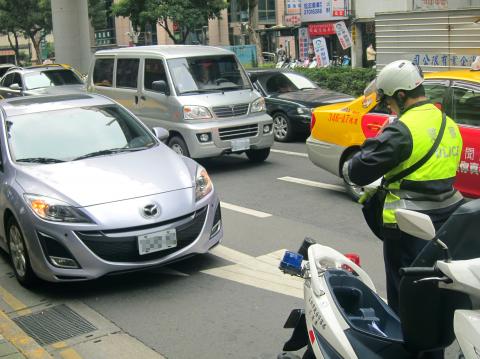In the past police had a reputation for writing a lot of traffic tickets, giving the impression they are not only cops, but robbers, too. They are keen to eradicate this image, and the number of tickets given out by policemen has been continuing to fall. According to statistics from the National Police Agency (NPA), people received just over 8.5 million traffic tickets in 2010, about 1.02 million less than the previous year. This figure marks a record low compared to the last few years.
According to the statistics, the number of category A1 traffic accidents — those in which the victims die within 24 hours — fell by 45 compared to 2009. The NPA said this was because policemen were, on the one hand, cracking down on serious traffic violations, and on the other adopting a policy of persuasion rather than punishment. When it comes to minor traffic violations they favor persuasion. This means that the number of both A1 traffic accidents and traffic tickets have fallen.
Lately the NPA has been reminding police again and again to only hand out tickets when it helps to improve traffic. It also emphasized the fact that tickets are reviewed, and that it reflects badly on senior officers when tickets are given out when they shouldn’t have been, especially in particularly conspicuous or unusual cases. It uses a series of measures to train police in when tickets should be given out. We are seeing less of the kind of glaring mistakes of the past.

Photo: Tsai Wei-chi, liberty times 照片:自由時報記者蔡偉祺
It is understood that nationwide the police used to give out nearly 20 million traffic tickets a year, opening them up to criticism from the public that they were ripping people off. Since then the police have changed their approach. They no longer use hidden cameras, and the number of tickets has been falling since 2003, dropping to around 10.69 million tickets in 2004. This figure was pretty consistent for the next few years, but fell below 10 million for the first time in 2009.
The police gave out 8,549,228 tickets in 2010, a fall of 1,026,013 compared to the 9,575,241 given out in 2009, representing a drop of over 10 percent. Looking at it more closely, the majority, more than 2.3 million, were speeding tickets, followed by those for illegal parking, accounting for around 1.7 million tickets. Third was for running traffic lights, for which more than 1.29 million were given.
Police statistics show that the highest number of tickets, 1.9 million, were given out by police in Taipei City, followed by those in New Taipei City, at 1.1 million, and then those given out by the National Highway Police Bureau (NHPB), in third place with more than 700,000 tickets.
(LIBERTY TIMES, TRANSLATED BY TAIJING WU)
由於警察過去經常開罰單,為洗刷「警察搶錢」印象,警察開交通罰單數量持續下滑,根據警政署統計顯示,國人九十九年一共接到八百五十四萬九千多張交通罰單,比前一年少了一百零二萬六千多張,這也是近年新低。
根據統計二零一零年A1類交通事故(指受害者於二十四小時內死亡)死亡人數,也比二零零九年少四十五人,警政署認為,這是因警察一邊取締惡性交通違規,另一方面確立「勸導重於處罰」政策,對於輕微交通違規,以勸導為主,使得A1類死亡人數與罰單能同步下降。
警政署近來時時提醒員警,開罰單必須要有益交通改善才開,加強罰單的審核機制,遇開單錯誤,若情形嚴重、離譜,還會對員警的長官連坐處分,利用一連串措施,逐步提升員警開單品質,以往罰單出現的離譜錯誤已不常見。
據了解,早年全國警察一年至少開出近二千萬張罰單,招致警察向老百姓「搶錢」批評,後來警方改變取締方式,不再以偷拍方式取締,使得罰單數從二零零三年開始下降,二零零四年更降至一千零六十九萬張,之後便一直維持這個數量,但二零零九年首次低於一千萬張。
二零一零年警察機關一共開出八百五十四萬九千二百二十八張交通罰單,較二零零九年的九百五十七萬五千二百四十一張,減少一百零二萬六千零一十三張,下降比率超過一成。進一步分析,以超速最多,共取締二百三十多萬件,其次是違規停車,有一百七十二萬餘件,第三名是闖紅燈及其他不遵守號誌,共開出一百二十九多萬張罰單。
依取締機關統計,以台北市開出一百九十萬餘張罰單最多,新北市去年開出一百一十一萬多張居次,第三為國道警局的七十萬餘張罰單。
(自由時報記者黃敦硯)

本文由生成式 AI 協作,本刊編輯編修。 Have you ever wondered how an athlete who once performed flawlessly can unexpectedly struggle with the simplest tasks? Imagine an __1__ pitcher who suddenly can’t find the strike zone—this is the “yips” in action. This __2__ phenomenon primarily affects athletes in sports like baseball and golf. It is characterized by a sudden loss of motor skills, leading to difficulties with routine actions that were __3__ before, such as a pitcher’s throw or a golfer’s putt. For instance, American baseball pitcher Steve Blass, who had a stellar performance in the 1971 World Series, suffered a sudden inability

A: Apart from 2NE1, Rain and Maroon 5, Japanese band Yoasobi is set to hold two shows in Taipei this weekend. B: Yoasobi? A: Yoasobi is a J-pop duo formed by Ayase and Ikura in 2019, and it’s loved by young people. Haven’t you heard? B: Oops, I’m feeling a little old. A: It sings the theme songs of “Oshi No Ko” (“My Idol’s Children”) and other TV series, leading it to gain popularity among young people. A: 除了2NE1、Rain、魔力紅,日本熱門樂團Yoasobi本週末也將連唱兩場。 B: Yoasobi樂團? A: 這是由Ayase、Ikura在2019年組成的雙人團體,近年來大受年輕人歡迎!你沒聽過嗎? B: 天啊我覺得自己老了。 A: 他們唱了《我推的孩子》等人氣影視作品主題曲,所以大受年輕人喜愛。 (By Eddy Chang, Taipei Times/台北時報張聖恩)

A: Happy Year of the Snake! Did you do anything special during the Lunar New Year holiday? B: I went to K-pop girl group Apink’s concert. How about you? A: I just stayed at home. But I’m going to girl group 2NE1’s show on Saturday. B: Wow, I really love their megahit “I Am the Best,” better known by its Korean title “Naega jeil jal naga.” A: I’m so glad that 2NE1 reunited last year, eight years after they disbanded in 2016. A: 蛇年快樂!你春節有做什麼特別活動嗎? B: 我去了南韓女團Apink的演唱會,你呢? A: 我都宅在家裡,不過這週六要去韓流天團2NE1的演唱會。 B: 我愛該團神曲《我最紅》,韓文歌名《Naega jeil jal naga》超洗腦。 A: 她們2016年解散8年後,去年終於合體真令人開心。 (By Eddy Chang, Taipei

The crimson hue of theater seats is a long-standing tradition that has persisted through centuries and across continents. This seemingly universal choice is influenced by a fascinating combination of historical, visual, and practical factors. Inspired by the lavish aesthetics of Italian opera houses, where red has been a dominant color, movie theaters often adopt the red color __1__—a tradition that emerged in the late 19th and early 20th centuries. Associated with power, the color red was used in opera houses to __2__ an image of sophistication and grandeur. As opera spread across Europe, more and more opera houses adopted